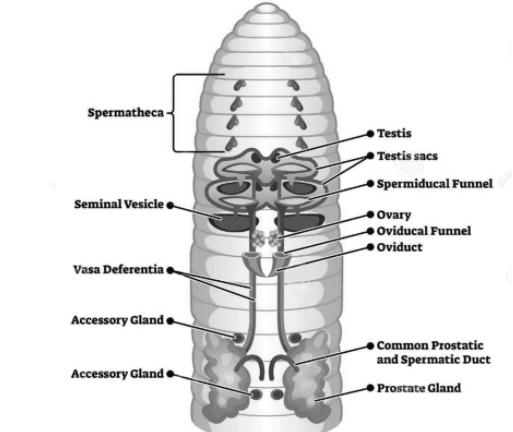
Draw a labelled Diagram of the reproductive organs of an earthworm.
Answer
573k+ views
Hint: The reproductive organs of earthworm are located towards the distal end of their body. They are hermaphrodites in nature i.e. they have both the male and female reproductive parts.
Complete answer:

Male Reproductive System: -The most important organs are listed below-
1) Testes & Testes Sac: Two pairs of testes are located at the 10th and 11th segments. These produce spermatogonia. The sac is bi-lobed, and the first sac at the 10th segment is larger than the second one.
2) Seminal Vesicles: An earthworm has two pairs of seminal vesicles. The spermatogonia mature in these vesicles and develop into spermatozoa. These are mature sperms; producing them is the main function of testes in earthworms.
3) Seminal Funnel: Earthworms have two pairs of seminal funnels. These are located at the 10th and 11th segments. These ciliated funnels play an essential role in passing on spermatozoa to the Vasa deferentia and onwards.
Female Reproductive System-
The important organs of the female reproductive system of earthworm are -
1) Ovaries: There is a single pair of ovaries attached to the 12th and 13th septa. Ova and multiple ovarian lobules rest within an earthworm ovary.
2) Oviducal Funnel: A saucer-shaped structure, an oviducal funnel is located in the 13th segment. The funnel ends in a short and conical tube-like structure called an oviduct. Two of these oviducts meet at the 14th segment and then open out into the external genital pore.
3)Spermatheca: Each earthworm has 4 pairs of spermatheca. They are flask-shaped and have a short diverticulum. This is the area where sperm is stored. The 4 pairs are located laterally at the 5th to 9th segments.
Note:Labelling of the reproductive organs in the system must be done clearly and properly. The reproduction system must include both male and female reproductive organs. Earthworms are hermaphrodites but they cannot fertilize their own eggs because of their relative position of male and female genital aperture and they are protrandous i.e. male sex mature earlier than female gametes.
Complete answer:

Male Reproductive System: -The most important organs are listed below-
1) Testes & Testes Sac: Two pairs of testes are located at the 10th and 11th segments. These produce spermatogonia. The sac is bi-lobed, and the first sac at the 10th segment is larger than the second one.
2) Seminal Vesicles: An earthworm has two pairs of seminal vesicles. The spermatogonia mature in these vesicles and develop into spermatozoa. These are mature sperms; producing them is the main function of testes in earthworms.
3) Seminal Funnel: Earthworms have two pairs of seminal funnels. These are located at the 10th and 11th segments. These ciliated funnels play an essential role in passing on spermatozoa to the Vasa deferentia and onwards.
Female Reproductive System-
The important organs of the female reproductive system of earthworm are -
1) Ovaries: There is a single pair of ovaries attached to the 12th and 13th septa. Ova and multiple ovarian lobules rest within an earthworm ovary.
2) Oviducal Funnel: A saucer-shaped structure, an oviducal funnel is located in the 13th segment. The funnel ends in a short and conical tube-like structure called an oviduct. Two of these oviducts meet at the 14th segment and then open out into the external genital pore.
3)Spermatheca: Each earthworm has 4 pairs of spermatheca. They are flask-shaped and have a short diverticulum. This is the area where sperm is stored. The 4 pairs are located laterally at the 5th to 9th segments.
Note:Labelling of the reproductive organs in the system must be done clearly and properly. The reproduction system must include both male and female reproductive organs. Earthworms are hermaphrodites but they cannot fertilize their own eggs because of their relative position of male and female genital aperture and they are protrandous i.e. male sex mature earlier than female gametes.
Recently Updated Pages
Why are manures considered better than fertilizers class 11 biology CBSE

Find the coordinates of the midpoint of the line segment class 11 maths CBSE

Distinguish between static friction limiting friction class 11 physics CBSE

The Chairman of the constituent Assembly was A Jawaharlal class 11 social science CBSE

The first National Commission on Labour NCL submitted class 11 social science CBSE

Number of all subshell of n + l 7 is A 4 B 5 C 6 D class 11 chemistry CBSE

Trending doubts
10 examples of friction in our daily life

One Metric ton is equal to kg A 10000 B 1000 C 100 class 11 physics CBSE

Difference Between Prokaryotic Cells and Eukaryotic Cells

1 Quintal is equal to a 110 kg b 10 kg c 100kg d 1000 class 11 physics CBSE

State the laws of reflection of light

Explain zero factorial class 11 maths CBSE




